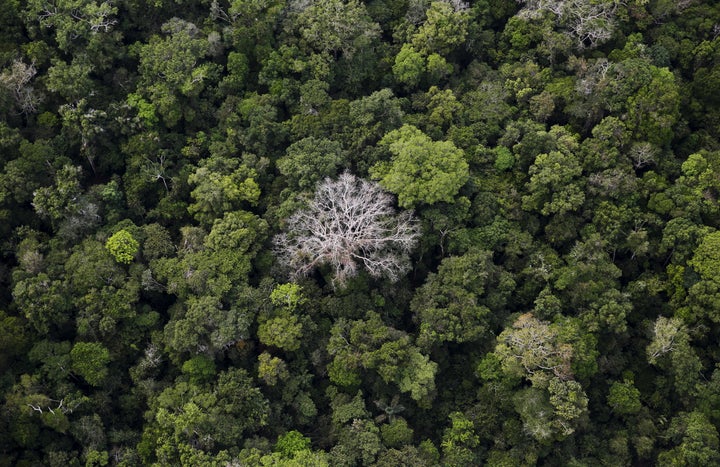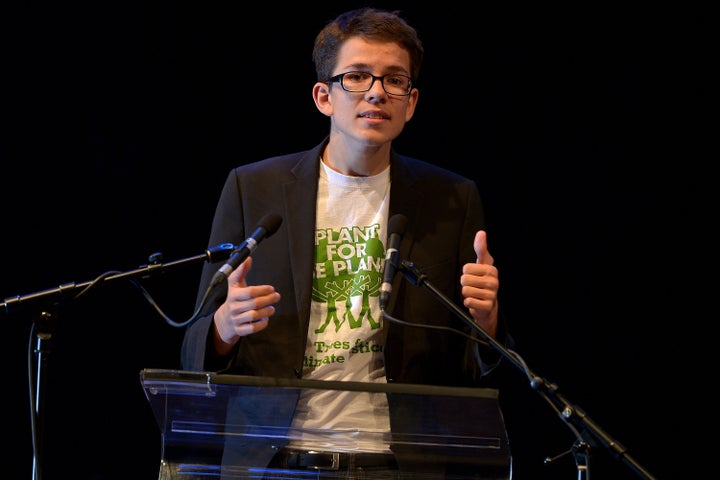
Felix Finkbeiner is a young man in a hurry to get the world to plant trees. The 19-year-old from a small Bavarian village near Munich, now studying at a university in London, has founded a global youth movement, Plant For The Planet, which has spearheaded the planting of over 15 billion saplings, signed up 75,000 children as climate ambassadors.
Alongside setting up Change Chocolate, a successful fair-trade chocolate company to raise money, the tall, spectacled teenager has joined with three of the world’s biggest conservation charities to launch the most ambitious reforestation project in history.
The Trillion Tree campaign aims to get the world to plant 1 trillion trees in the next 30 years. To put that into context, scientists calculate there are currently 3 trillion trees growing worldwide.
Each mature tree absorbs about 22 pounds of carbon dioxide per year, Finkbeiner says, “so one trillion could capture 25 percent of all human-made CO2 emissions and help to keep global temperature rise below the crucial 2-degree C limit. It does not replace the need to avoid carbon emissions, as agreed in Paris, but is a necessary addition.”
Finkbeiner thinks big. He has spoken at the United Nations and European Parliament, and reels off numbers like the politicians, who he says have mostly failed to act.
No one paid him much attention back in 2008, when, at age 9 and inspired by Kenyan Nobel Peace Prize winner and tree-planter Wangari Maathai, he announced at his primary school assembly that he intended to get children to plant 1 million trees in every country.
But his motto, “Stop talking, start planting,” went viral. Competition between schools, “pester power,” and slick social media saw the million-tree target reached within two years.

Since then, Plant for the Planet has grown into a well-funded NGO backed by the World Wildlife Fund, the German government and others, and has taken over a U.N. environmental campaign to get the world to plant 1 billion trees. An estimated 15.2 billion trees have been planted since 2006 by individuals, governments and businesses.
While adults talk about addressing climate change, Finkbeiner says, young people act. “Children could plant 1 million trees in every country on earth and offset CO2 emissions all on their own, while adults are still talking about doing it,” he says.
Some people doubt it is possible to plant so many trees in such a short time. In Mexico last month, talking at a world sustainable development conference, Finkbeiner was challenged by journalists about the practicalities of planting on such a scale, and was questioned whether it would mean giant plantations and a reduction in the amount of land available for growing human food.
Some researchers point to the social consequences of planting on such a vast scale, and say the massive, managed plantations of trees needed to hold temperatures below the 2-degree C limit from pre-industrial levels could trigger potentially irreversible changes in the planet.
Lena Boysen, now a researcher with the Max Planck Institute for Meteorology in Germany, is lead author of a study investigating the potential of trees as carbon sinks. Extensive tree plantations “would require a major fraction of the global land surface with intolerably large environmental and social costs,” Boysen says. “Our results showed that extensive terrestrial carbon dioxide removal measures are unable to counteract business‐as‐usual emissions without eliminating virtually all natural ecosystems and compromising food production and biosphere functioning.”
But Finkbeiner is undeterred, and says he is also backed by science. Research shows the world has space for up to 589 billion mature trees without competing with agricultural lands, he says.
“We need to plant at least a trillion trees to get 600 billion, since many will not survive,” he says. “Additionally, we must protect the 170 billion trees in imminent risk of destruction.”
Most of the planting, says Finkbeiner, should be in the so-called Global South, because trees generally grow faster than in Europe or North America, and are cheaper to plant and maintain.
Tom Crowther, a professor at Swiss university ETH, who led the Yale University study that calculated the number of trees on the planet and advises the U.N. environment program, says the trillion-tree target is a good goal. “Given enough support from the thousands of restoration efforts around the world, it is possible to make a massive dent in this goal,” Crowther says. “They must understand which soils to restore, which species to plant, how to manage the ecosystem following restoration, along with many other ecological questions.”
Trees are far more than CO2 sinks, says Finkbeiner. “They can provide millions of jobs and other benefits. The use of local timber-intensive materials in construction substitutes CO2-intensive materials like steel and concrete, and the timber industry can create hundreds of millions of additional jobs and wealth in the Global South, thus reducing population growth and migration.”
Besides, he says, the initiative’s timing is good. One-quarter of all the emissions reductions pledged by countries in the 2015 Paris agreement will come from tree planting and land restoration. Countries, including the U.S., U.K. and Germany, have promised to plant and restore large areas of degraded forest and other land as a response to the climate crisis.
The U.N. has set a target to restore 350 million hectares by 2030 – an area bigger than India. A single province in Pakistan has just planted 1 billion trees. China plans to create forests the size of Ireland. And many Latin American countries have pledged to reforest on a large scale. Meanwhile, Ethiopia, Niger, Mali and other African countries are strongly backing agroforestry and the reforestation of degraded land.
Finkbeiner is immensely proud of the 13,500-hectare (33,359-acre) Plant for the Planet ranch in Campeche province, near Cancun, Mexico, which his foundation bought in 2014 and which now employs 78 people. The land had been deforested, and the aim is to plant 10 million trees there by 2020.
The climate crisis does not need technological intervention to resolve it because trees are by far the simplest and most efficient way to absorb the world’s emissions, Finkbeiner says. “Why not use them? Sometimes adults are really difficult to understand.”
In Mexico last month, he pressed his argument: “We know it is a complex challenge and no, we don’t have all the answers. But in the end, If we follow the scientists and we act and in 20 years find out they were wrong, well we didn’t make any mistakes. But if we follow the skeptics and in 20 years we find out that they were wrong, it will be too late to save our future.”
For more content and to be part of the ‘This New World’ community, join our Facebook Group.
HuffPost’s ‘This New World’ series is funded by Partners for a New Economy and the Kendeda Fund. All content is editorially independent, with no influence or input from the foundations. If you’d like to contribute a post to the editorial series, send an email to thisnewworld@huffpost.com